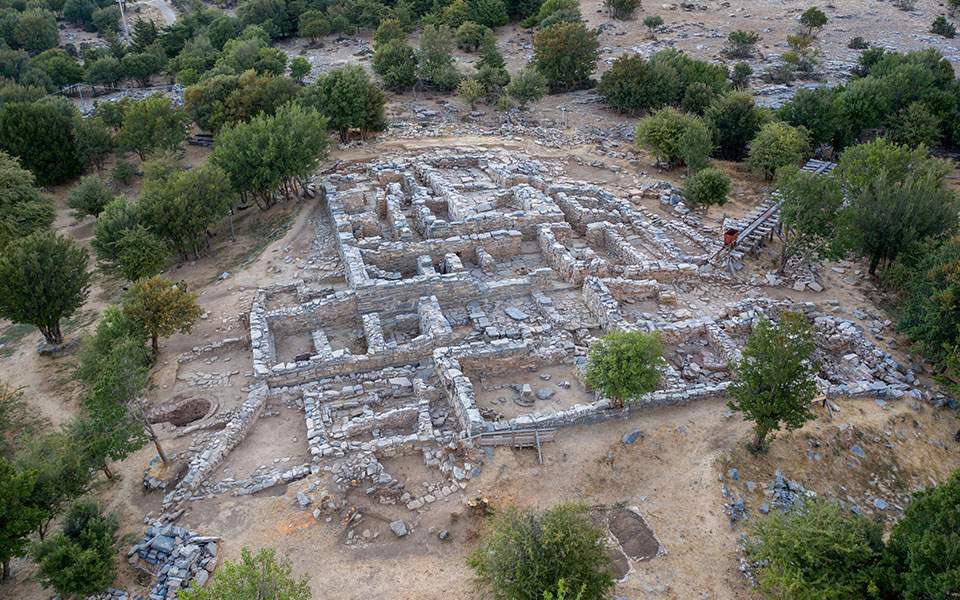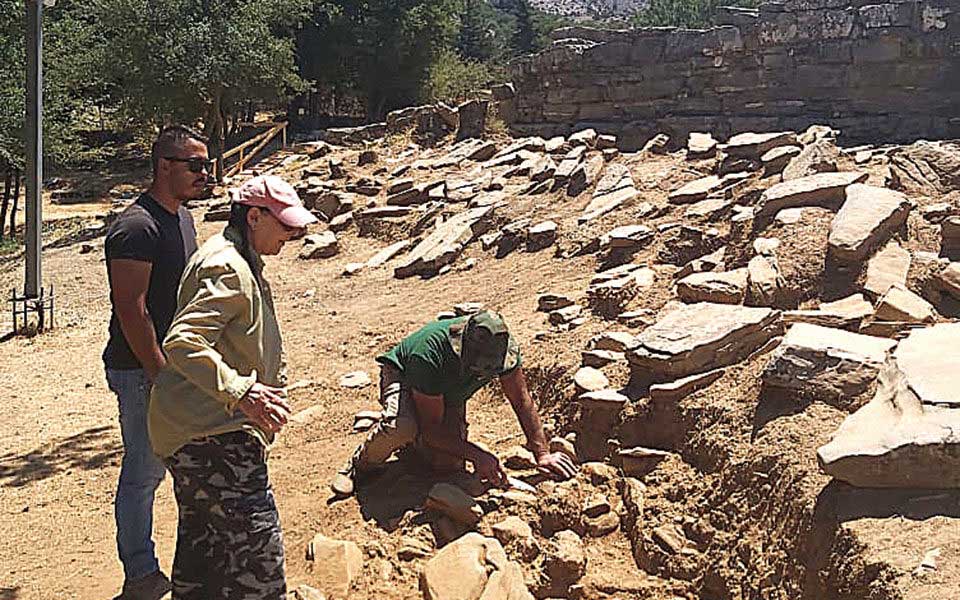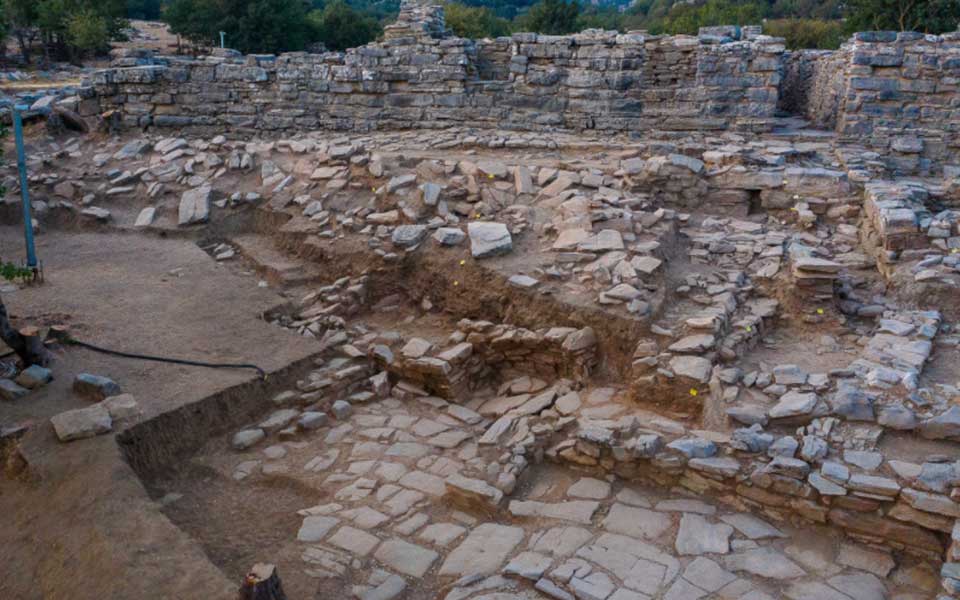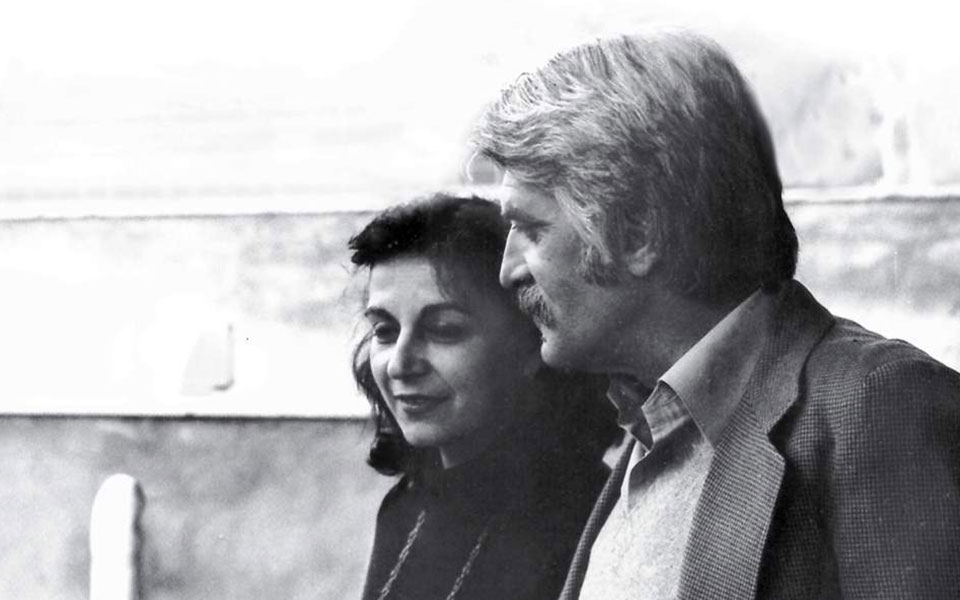Wild Crete: The Uncharted World of Sfakia
Discover remote Sfakia in Crete with...

First discovered in 1982, excavations at the mountainside Zominthos palace site started in 1983.
While his animals grazed in fields around Zaminthos, in the foothills of Mount Ida, a chance discovery by a local shepherd from Anogia in 1983 prompted renowned archaeologist Yannis Sakellarakis to explore the wider area. At the time, he was excavating at the site of the sacred Ideon Andron Cave (Cave of Zeus), but his ears pricked up when he heard the distinctive prehistoric-sounding word with the suffix -nthos – a Minoan word.
The shepherd, Giachountis Anogeianos, took him to see the scattered remains of the mountainside palace. The archaeologist could immediately identify the walls nestled among the bushes on the plateau, 10 kilometers from Anogia village. Over the years, a building complex of more than 150 rooms were painstakingly uncovered, remarkable two-storey and three-storey buildings, in which the ancient inhabitants once gathered the wealth of the wider region of Psiloritis.
After 40 years of work, site director Efi Sapouna-Sakellaraki, Honorary Director of Antiquities, is finally bringing the excavations to a close. Dr Sapouna-Sakellaraki, who continued the excavation of the site on behalf of the Archaeological Society in 2010, following the death of her husband, Yannis, will now turn her attention to the scientific publication of the site, which will be extensive.
Smaller in size but similarly luxurious to the palaces of Knossos and Phaistos, Zominthos is the first and only Minoan palatial site to have been discovered on a mountain, at an altitude of 1,200 meters. “The palace of Zominthos was a sturdy building where the descendants of the Knossos dynasty lived.” The labyrinthine complex was built on an impressive and strategic spot with access to fresh water and rich vegetation. It had columns and frescoed halls, large corridors and internal atriums, paved floors that were preserved even on the upper floors, private spaces, ramps, stairwells, skylights, workshops and warehouses, spaces for multifaceted gatherings, and all kinds of sanctuaries. It appears that the site served as a large religious, political and economic center that replaced in the winter months the role of the Ideon Andron Cave, which was inaccessible.

Site director Dr Efi Sapouna-Sakellaraki continued the excavation following the death of her husband, Yannis Sakellarakis, in 2010.
The complex began to be built in 1900 BC but was destroyed by an earthquake. On the ruins of the Protopalatial period, 1900-1700 BC, the building of the Neopalatial period was built, 1700-1600 BC. “The later remains we found, such as the shells of buildings from the Geometric (900-700 BC) and Classical (480-323 BC) periods, and the large Roman building, show that it was an important space that they used over the years. The oldest was also the largest building and had the religious elements that we find in the peak sanctuaries (figurines, pottery, and so on). While it had a long history, the newer complex eventually replaced the Ideon Andron Cave.”
The palace complex was in operation well beyond antiquity. It was exploited even by the Venetians in the Middle Ages. A coin of the Doge of Venice Pietro Gradenigo (1289-1311), coinciding with the 4th Crusade and the period of Venetian rule in Crete, was found by the excavation team, and a local cheese factory in the area is called “Venetian.”
How does the excavator feel with the closure of such an important excavation after almost four decades? “The plan was to close last year, but when we finished, we located the remains of an earlier phase of the palace under the slabs of the northern courtyard. It was a continuation of the old palace that I had already revealed parts of. Of course, there are other places to explore, e.g. on the threshing floor, but they are badly damaged. For me, the chapter of Zominthos does not close, only the vision of Yannis Sakellarakis closes.”
Dr Sapouna-Sakellaraki does not believe in the extension of the investigations ad infinitum. “I want to finish the final publication of Zominthos. Perhaps one day other parts of this rich region will be investigated, but I am touched that the importance of this palace has been recognized. In fact, on May 17, 2023, I will travel to London to talk about Zominthos as part of the “Michael Ventris Memorial Lecture series. It’s a very honorable invitation.”

The excavations in 2020 focused on a paved area with irregular slabs that were found fallen sideways.
The house of the renowned archaeologist is full of large binders with material for the scientific publication of Zominthos. “The joy I feel when I see all these binders packed full of information, as I study in my office, is greater than the moment of the excavation where I record something that no one will ever see again. I am obliged to go about the excavation of artifacts in a thorough and practical way, almost without emotion. I experience the thrill of the discovery when I work on it afterwards. After all, excavation without publication means nothing. After the death of Yannis, I published five volumes of excavation reports on Kythera, as well as the three-volume scientific work by the Archaeological Society for the Ideon Andron Cave.”
Five hundred copies of the preliminary 128-page publication of the Zominthos excavation, an elegant edition in both Greek and English, entitled “Zominthos – A palace on the mountain,” was published by the Psychas Foundation. Unfortunately, it was not widely marketed which is a great shame because it is well-written and easily accessible for the non-specialist reader.
The existence of water in Zominthos favored the flora and created the right environment for livestock farming and the creation of a residential center. In this privileged position, an intelligent architect created a palace related to Knossos and the Ideon Andron Cave. “For a long time, Knossos controlled the Ideon Andron Cave, an ‘international’ center of worship in the Mediterranean, a sacred place related to the upbringing of Cretan Zeus, who was born and died here every year, as well as the Minoan young god,” notes the veteran archaeologist. The Zominthos palace was not only built to continue the ritual of worship at the Ideon Andron Cave during the difficult winter months, when access there was impossible, but also for financial reasons. “Mainly so as not to lose the revenue from the visitors, the faithful who arrived from various parts of the Mediterranean.”
There were many emotions and findings over the years for the excavator, such as the female figurine, the so-called “Lady of Zominthos,” the burnt tree trunk lined with 90 gold leaves, a small gold nail, anthropomorphic and zoomorphic figurines, a clay stalk-dedication of hair in adulthood, and many others.

Dr Efi Sapounas-Sakellarakis next to her partner, the late Yannis Sakellarakis.
However, the renowned archaeologist urges us not to dwell only on the individual artifacts, but on the wider site and the truths it reveals. For example, the design of the palace with its excellent drainage and water runoff system. The archaeologists also revealed evidence for highly developed technological know-how at the complex, including the metallurgy workshops identified during the pandemic years, as well as a workshop that processed crystal objects, discovered by the late Yannis Sakellarakis. Later, a perfumery workshop was also found.
Zominthos was not only a religious center. There were other reasons for its founding, she emphasizes in the publication. “Reasons of political power and economy. An element of the economy was the harvesting of aromatic and healing plants, such as dittany (Origanum dictamnus), which Aelianos mentions and is a phosphorescent plant for the healing of wounds.” The main resources were livestock farming, tanning, and beekeeping. Bees, after all, also had a religious significance in Minoan worship.
Zominthos, the first Minoan palace on a mountain, managed all the wealth of Psiloritis. “It was logical for a member of the Knossos dynasty to settle in Psiloritis, in order to ensure the control of the primary products,” notes the excavator. “With the specialization of the population of Zominthos (shepherds, farmers, craftsmen, merchants) and the existence of the corresponding economic units, the choice of creating a large center in the mountains appears obvious: the reason was the economy and, of course, the political power and rich natural resources from the surrounding area.”
Efi Sapouna-Sakellaraki remembers the evenings of the first years when after the day’s work under the hot sun, feasts, songs and Cretan dances followed, with Psarantonis and Louis of Anogia. But also moments in the destroyed shelter that Yannis rebuilt and made room for his favorite books. In the “chostra,” the hiding place where the shepherds put their weapons, he kept for several years the Laws of Plato and the poetry of Elytis, which they read in the evenings by the light of a candle.
“We approached the palace of Zominthos with humility and it was revealed to us through the fragments, a resplendent past.” Another great story of her life that closes for good. How will the tireless archaeologist feel away from the excavation pits? “Right now I’m making a small incision in Archanes to find additional clues,” she laughs with satisfaction. “A little arduous, I admit, but I have some question marks for which I am looking for the answers”…
This article was previously published in Greek at kathimerini.gr.
Discover remote Sfakia in Crete with...
A compact archaeological guide to the...
From olive presses and traditional costumes...
Experience Crete’s slow food philosophy where...